Business
Here’s what the most popular American vehicles actually cost the average driver
Published
2 years agoon
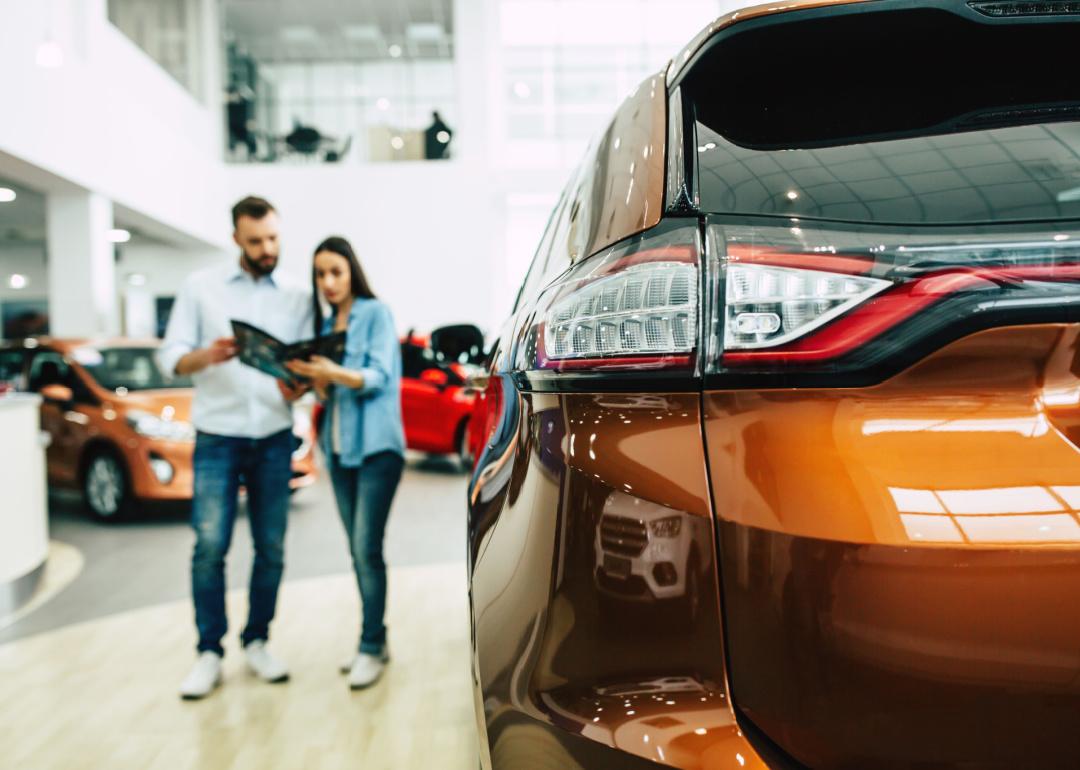
Here’s what the most popular American vehicles actually cost the average driver
The cost of a car or truck is more than just the price you pay driving it off the lot. Every year, auto owners need to factor in a number of different costs to determine the true price of owning a particular model. Everything from the cost of repairs to the price of fuel goes into determining such a cost.
As supply shortages and varying demand have made the current auto market one of the most challenging in recent memory, the idea of affordability has begun to change. CoPilot estimated the cost of the most popular vehicles from 2021 for an average U.S. driver based on data from its CoPilot Price Pulse tool, Car and Driver, and the U.S. Department of Energy. The number of miles driven and the mix of highway and city driving came from estimates of countrywide averages provided by the DOE. Full details about the DOE’s methodology can be found here. The current market price of each vehicle comes from the Price Pulse tool and looks at the price of a 2021 model for each vehicle.
The most basic model for each vehicle was chosen. Fuel price was collected from AAA’s gas price tracker as of Sept. 1, 2022. Annual operating costs and cost per mile are for the cost during the first year and include fuel, tires, maintenance, registration, license, and insurance. The ranking is based on the number of vehicles sold in 2021.
All of the vehicles on this list are gas engine models. The Honda Civic has the best fuel efficiency, getting 37 mpg average, which helps it take the top spot in terms of cost. The Honda Civic also has the lowest cost per mile of any car on this list at $0.29. The highest cost is a tie between the Ford F-150, the Ram 1500 Pickup, and the Chevy Silverado, which are all more expensive by $0.08 per mile. The difference may sound negligible, but considering the average number of miles put on any given vehicle is over 13,000 per year, that “negligible” amount translates to quite a chunk of change—around $1,078.
Continue reading for the full cost breakdown of the most popular vehicles.
![]()
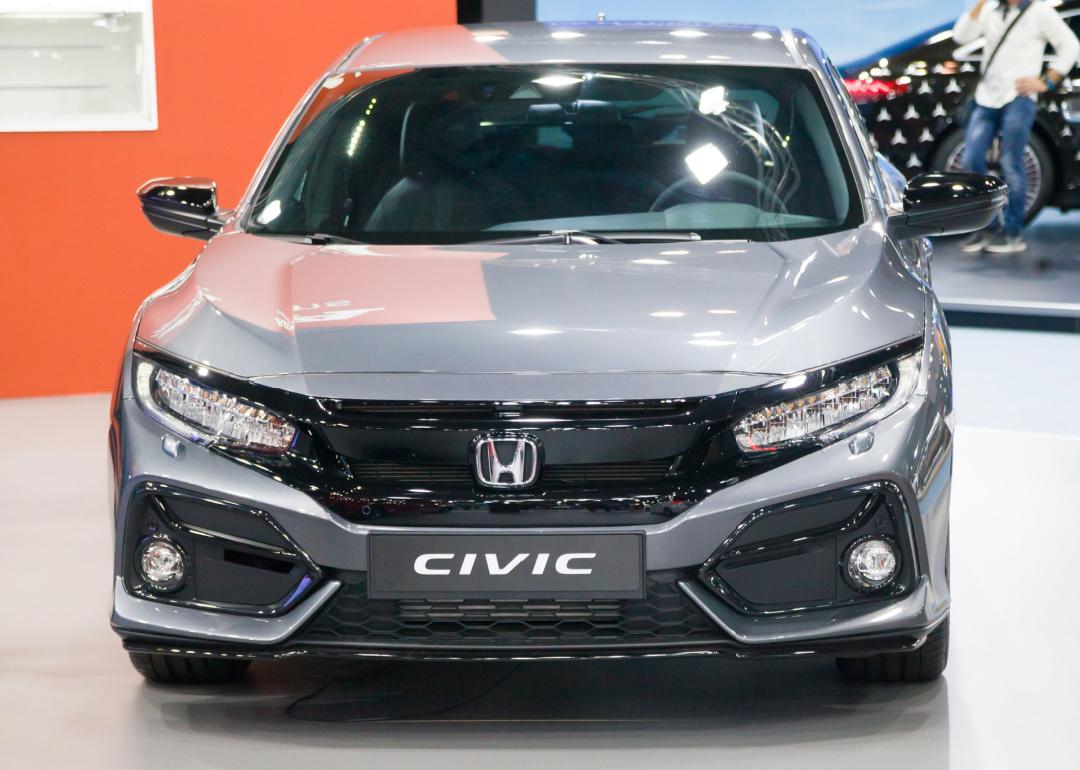
Santi Rodriguez // Shutterstock
#10. Honda Civic
– Model used for comparison: 2021 Honda Civic 4Dr 4cyl 1.5L Automatic (variable gear ratios)
– Annual operating cost: $3,496
– Annual fuel cost: $1,239
– Cost per mile: $0.29
– Annual emissions: 7,761 lbs CO2
– Units sold in 2021: 263,787
– Current market price of vehicle: $29,099
The Honda Civic is understandably popular, given its relatively low cost and reputation for reliability. Along with the affordability of the car itself, the Honda Civic also has a reputation for being inexpensive to maintain. Its average cost of maintenance over the first decade of its life is almost $2,000 less than the national average for sedans.
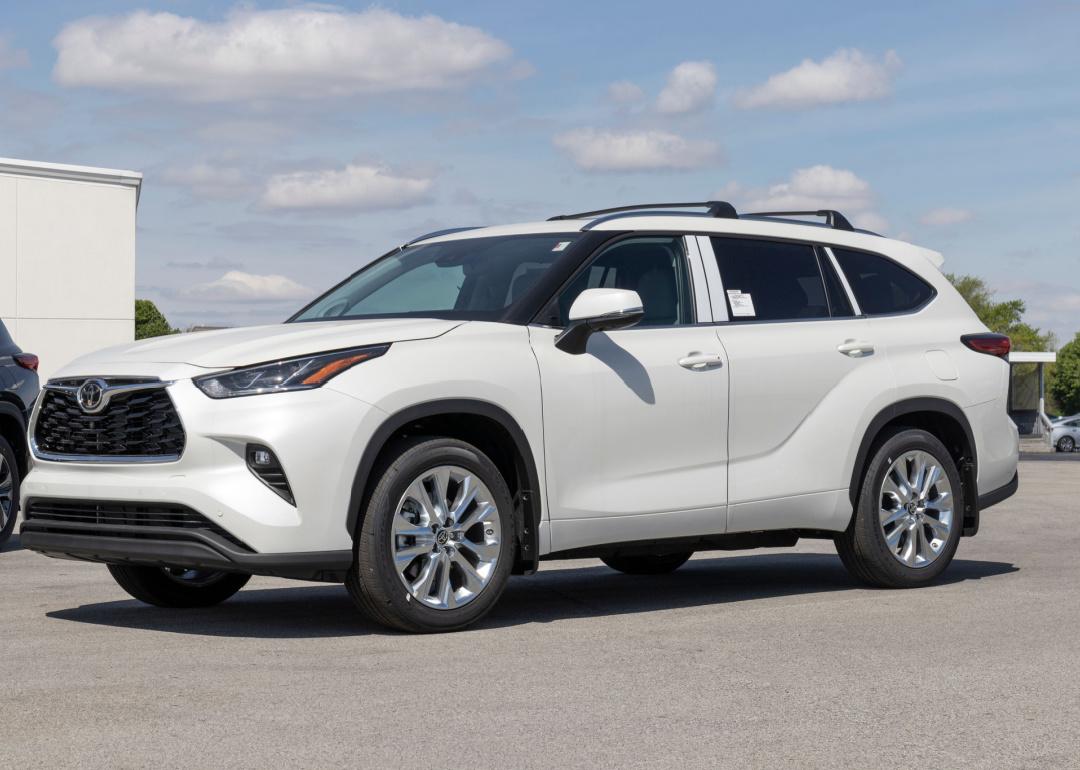
Jonathan Weiss // Shutterstock
#9. Toyota Highlander
– Model used for comparison: 2021 Toyota Highlander 6cyl 3.5L Automatic (S8)
– Annual operating cost: $4,179
– Annual fuel cost: $1,921
– Cost per mile: $0.35
– Annual emissions: 12,040 lbs CO2
– Units sold in 2021: 264,128
– Current market price of vehicle: $44,345
The Toyota Highlander gets high marks for fuel efficiency relative to other SUVs in its class. Car and Driver test-drove the 6-cylinder model and got 28 mpg. Edmunds also cited its solid fuel efficiency. Although the Highlander has a higher average annual fuel cost than other cars on this list, it is still far more cost-effective in terms of gas than many other cars of its size, such as Range Rovers or most model Jeeps.
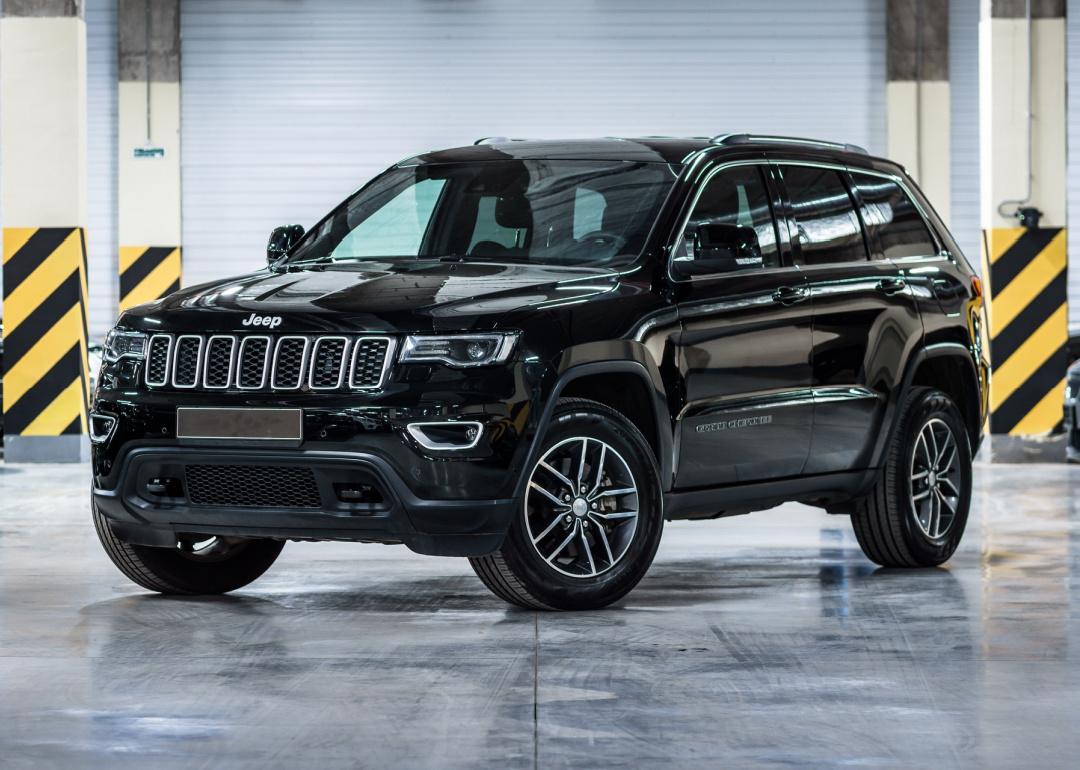
rebinworkshop // Shutterstock
#8. Jeep Grand Cherokee
– Model used for comparison: 2021 Jeep Grand Cherokee 2WD 6cyl 3.6L Automatic 8-spd
– Annual operating cost: $4,302
– Annual fuel cost: $2,044
– Cost per mile: $0.36
– Annual emissions: 12,811 lbs CO2
– Units sold in 2021: 264,444
– Current market price of vehicle: $42,883
Although Jeep Grand Cherokees are considered iconic Americans SUVs, they are not without their costs and issues. Repairs in particular can be pricey. One vehicle depreciation tracker found that there is a more than 30% chance a Cherokee owner will have to pay for a major repair in the first 10 years of ownership—nearly 10% more likely than for other SUV owners.
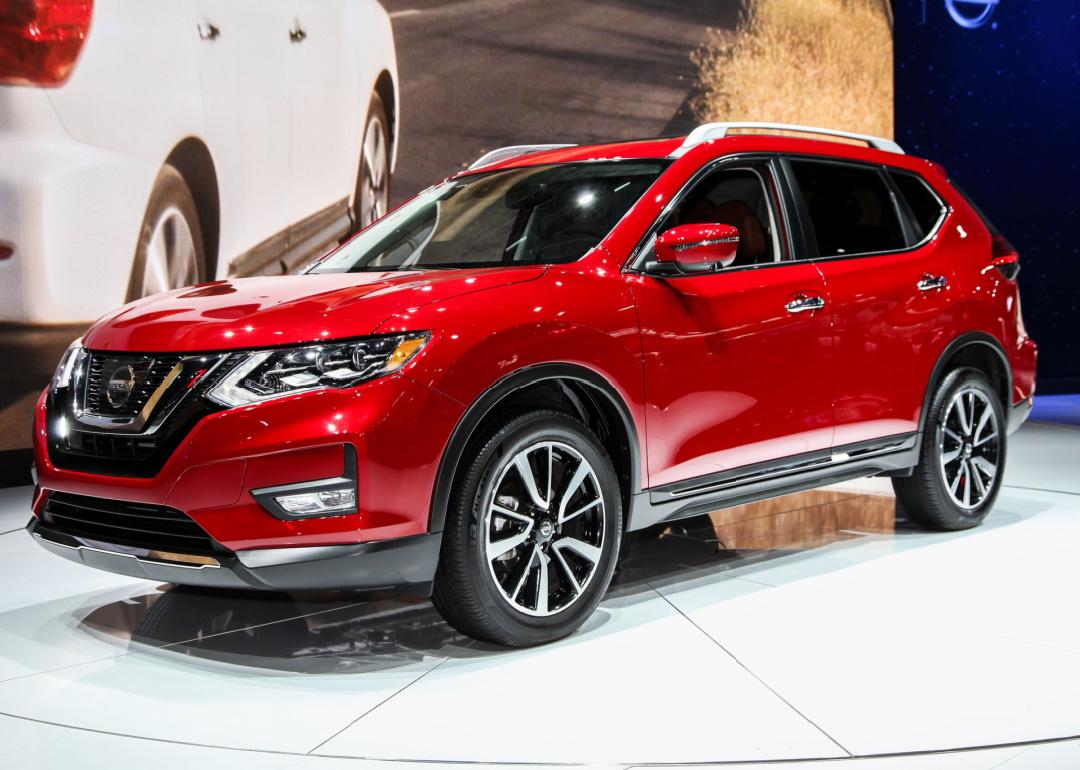
Miro Vrlik Photography // Shutterstock
#7. Nissan Rogue
– Model used for comparison: 2021 Nissan Rogue AWD SL/Platinum 3cyl 1.5L Automatic (AV-S8)
– Annual operating cost: $3,682
– Annual fuel cost: $1,425
– Cost per mile: $0.31
– Annual emissions: 8,930 lbs CO2
– Units sold in 2021: 285,602
– Current market price of vehicle: $33,760
The Nissan Rogue is a compact crossover and the company’s bestselling SUV in the United States. And the new models are giving new owners a lot to be happy with. Reviewers have praised in particular the model’s switch from a 2.5-liter naturally aspirated 4-cylinder engine to a standard 1.5-liter turbo-three, which makes for a powerful ride. Enhanced fuel efficiency is also a hallmark of the new model, offering 3 miles more per gallon than its prior iterations, as well as many of its competitors.
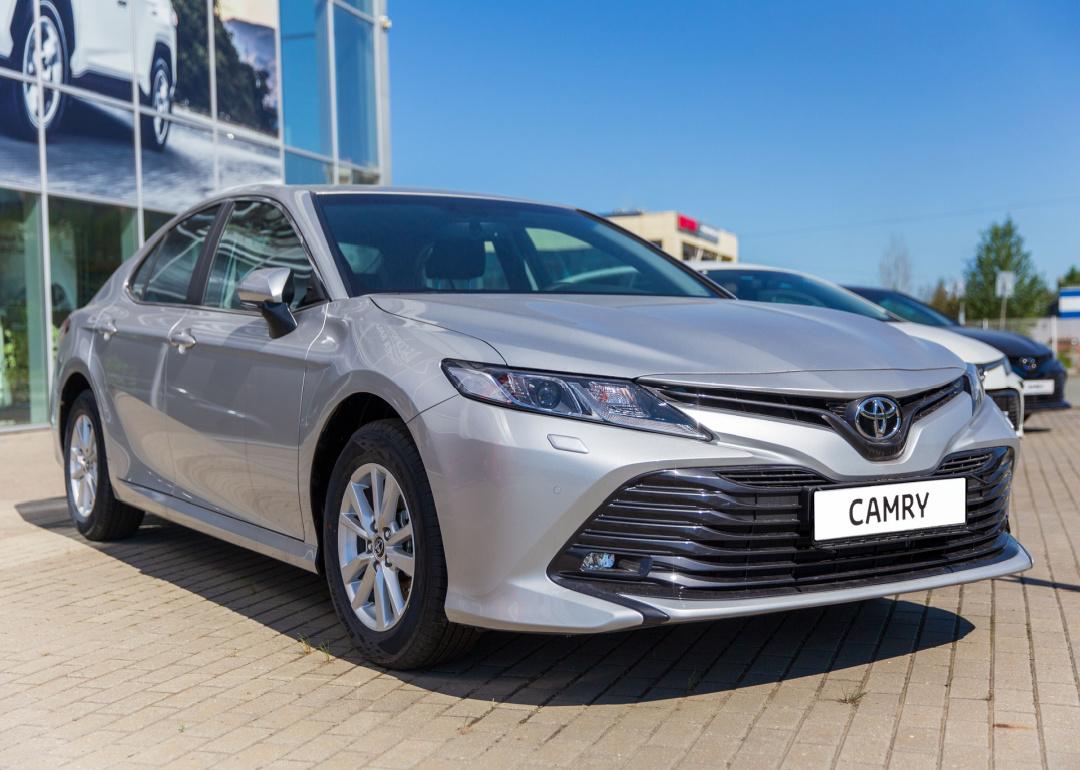
ArtEvent ET // Shutterstock
#6. Toyota Camry
– Model used for comparison: 2021 Toyota Camry 6cyl 3.5L Automatic (S8)
– Annual operating cost: $3,949
– Annual fuel cost: $1,691
– Cost per mile: $0.33
– Annual emissions: 10,601 lbs CO2
– Units sold in 2021: 313,795
– Current market price of vehicle: $31,499
The Toyota Camry has a reputation for reliability and affordability. The company in general is known for producing vehicles with low maintenance costs that typically require little in the way of major repair. The average Toyota costs around $420 a year to maintain for its first 10 years, and the odds of a major repair being needed in the first 10 years of ownership are lower than competitors’ vehicles in its class.
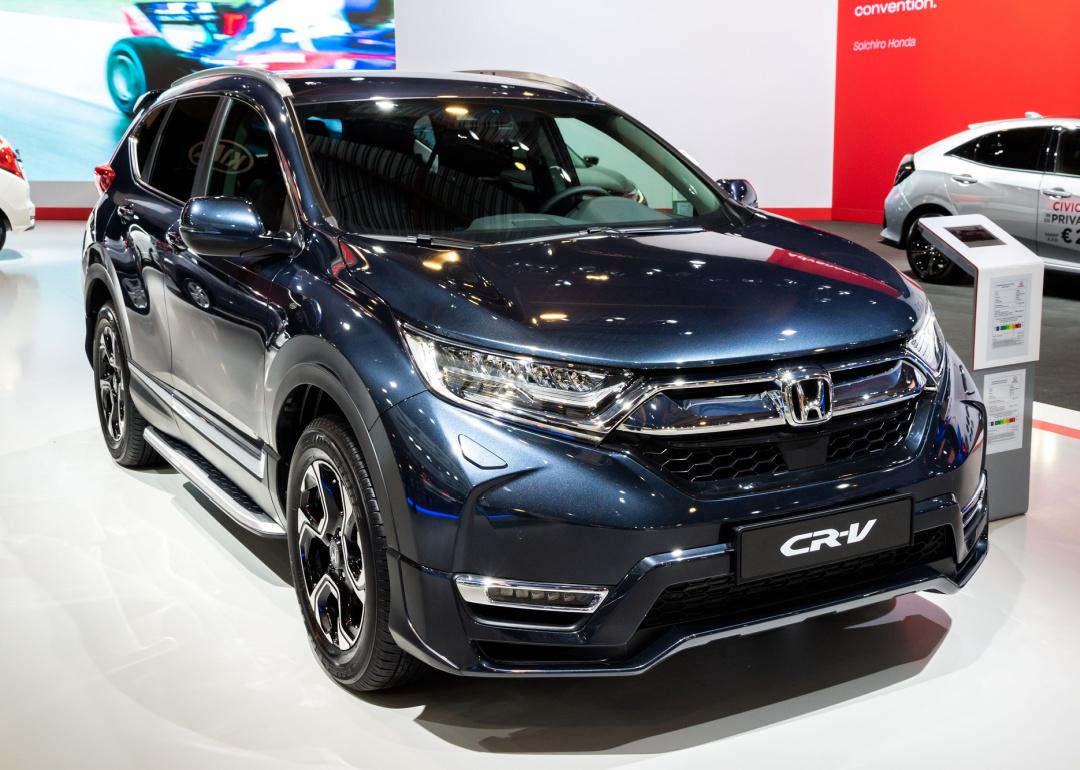
VanderWolf Images // Shutterstock
#5. Honda CR-V
– Model used for comparison: 2021 Honda CR-V AWD 4cyl 1.5L Automatic (variable gear ratios)
– Annual operating cost: $3,802
– Annual fuel cost: $1,544
– Cost per mile: $0.32
– Annual emissions: 9,681 lbs CO2
– Units sold in 2021: 361,271
– Current market price of vehicle: $35,077
The Honda CR-V gets high marks for quality and affordability in the SUV category. According to an Edmunds breakdown of the “true” cost of ownership, maintenance on the CR-V averages out to just under $900 annually for the first five years, but other sources put that figure at just under $400 for the same time frame. The CR-V also generates less CO2 per year compared to other SUVs like the Jeep Cherokee, meaning that its impact is as relatively light on the planet as it is on the wallet.
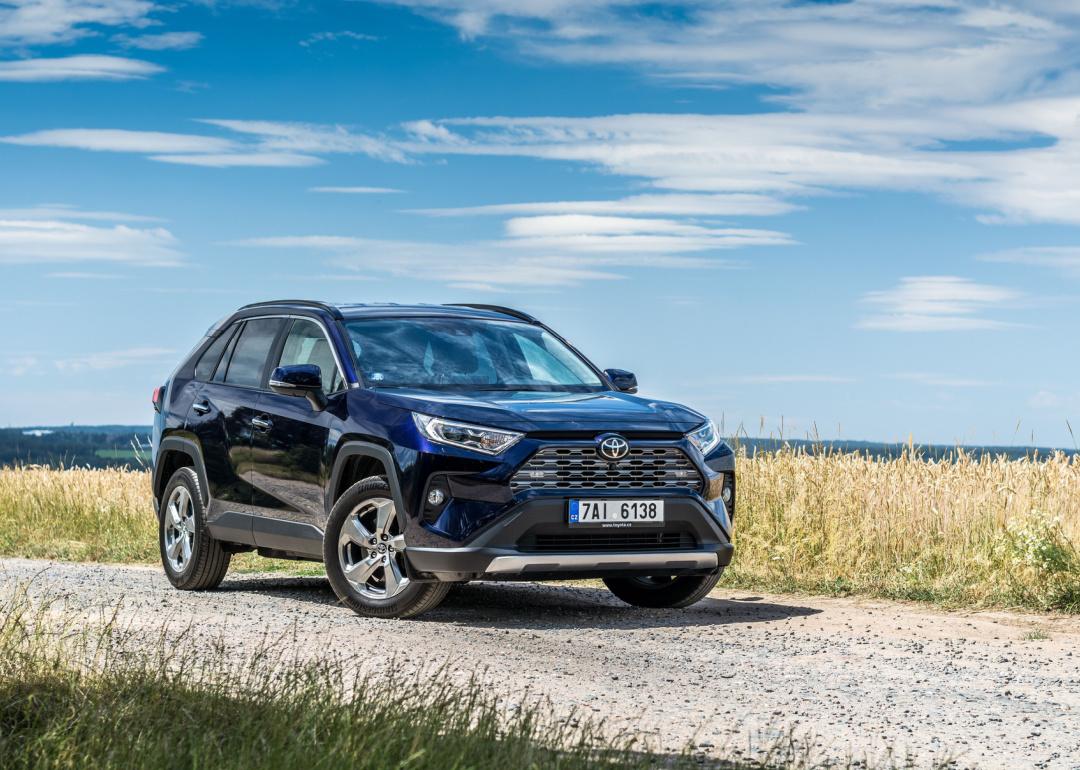
tomas devera photo // Shutterstock
#4. Toyota RAV4
– Model used for comparison: 2021 Toyota RAV4 4cyl 2.5L Automatic (S8)
– Annual operating cost: $3,734
– Annual fuel cost: $1,477
– Cost per mile: $0.31
– Annual emissions: 9,255 lbs CO2
– Units sold in 2021: 407,739
– Current market price of vehicle: $34,808
Toyota recently overtook General Motors as the top-selling car brand in America, and the RAV4 is its quintessential SUV. And although its CO2 emissions and gas costs are already low, new models promise even more for drivers looking to lessen their impact on the environment and lower their gas costs. A new hybrid model of the RAV4 is receiving praise from critics for its distinctive blend of the best qualities of both gas and electric cars, which means that new buyers can look for even lower annual fuel costs.
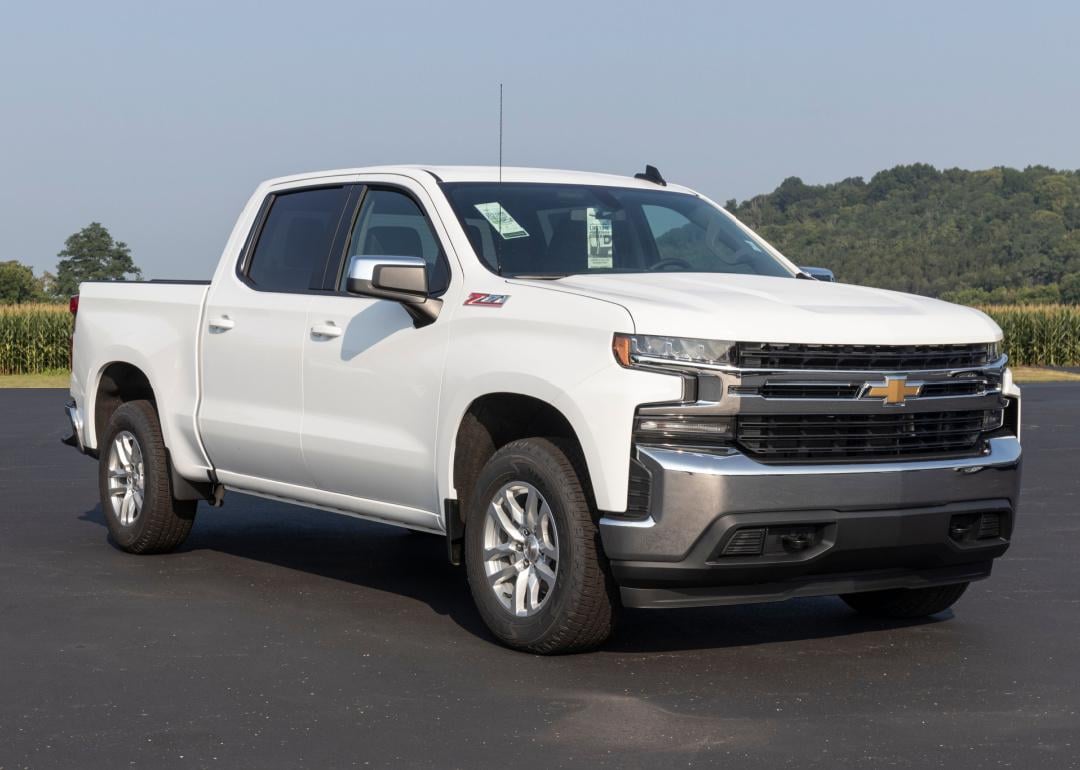
Jonathan Weiss // Shutterstock
#3. Chevrolet Silverado
– Model used for comparison: 2021 Chevrolet Silverado 2WD 4cyl 2.7L Automatic 8-spd
– Annual operating cost: $4,375
– Annual fuel cost: $2,118
– Cost per mile: $0.37
– Annual emissions: 13,274 lbs CO2
– Units sold in 2021: 519,774
– Current market price of vehicle: $48,513
The Chevrolet Silverado is a seminal American pickup truck, though as a larger vehicle it does have both a larger carbon output and higher fuel costs than many vehicles listed here. New models are being made specifically for off-roading, which means that along with fun for owners, additional maintenance costs to repair any damage could be on the horizon.
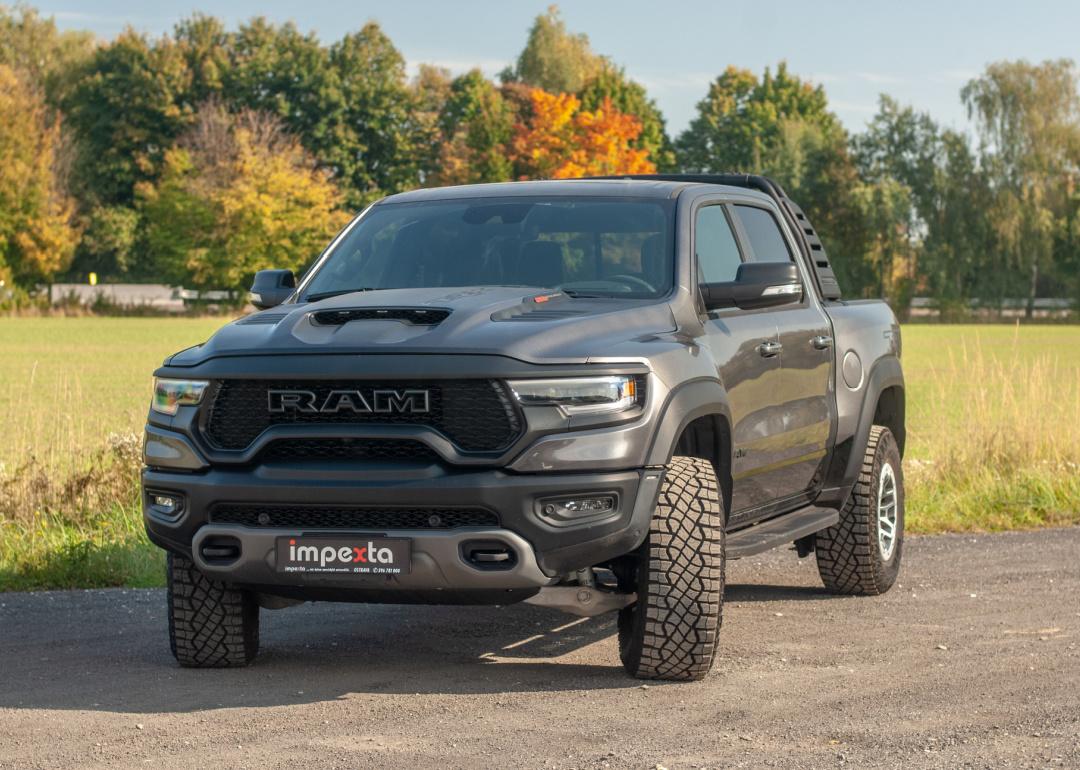
chorche de prigo // Shutterstock
#2. Ram Pickup
– Model used for comparison: 2021 Ram 1500 Classic 2WD 6cyl 3.6L Automatic 8-spd
– Annual operating cost: $4,466
– Annual fuel cost: $2,209
– Cost per mile: $0.37
– Annual emissions: 13,844 lbs CO2
– Units sold in 2021: 569,388
– Current market price of vehicle: $50,674
Ram Pickups are full-size trucks that were sold under the Dodge brand until 2009, when it launched as a stand-alone division. They have been named MotorTrend’s Truck of the Year on numerous occasions. There are also Ram Pickups specifically geared towards fuel-efficiency, such as the EcoDiesel, which even with a 3-liter V6 gets 33 mpg highway.
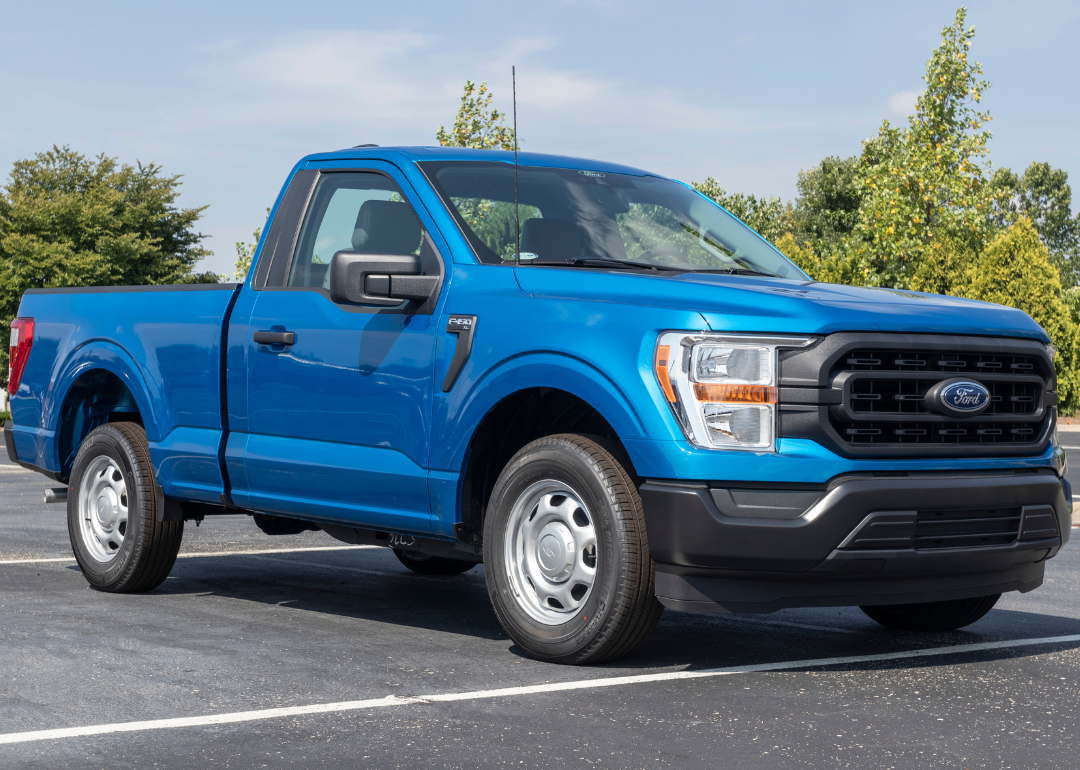
Jonathan Weiss // Shutterstock
#1. Ford F-Series
– Model used for comparison: 2021 Ford F-150 Pickup 2WD 6cyl 3.5L Automatic (S10)
– Annual operating cost: $4,442
– Annual fuel cost: $2,185
– Cost per mile: $0.37
– Annual emissions: 13,693 lbs CO2
– Units sold in 2021: 726,004
– Current market price of vehicle: $56,391
Perhaps the most iconic American truck is the Ford F-Series. The F-150 model has been the bestselling truck in America every year since 1976 and the top-selling vehicle of any kind since 1981. The company switched to using aluminum for certain parts of the truck traditionally fabricated from steel, which led to fears repair costs would rise. Those fears have, as yet, not been realized, though the Insurance Institute for Highway Safety had estimated that fender-benders would be pricier as a result. Real-world evidence has contradicted those initial estimates.
This story originally appeared on CoPilot and was produced and
distributed in partnership with Stacker Studio.
Founded in 2017, Stacker combines data analysis with rich editorial context, drawing on authoritative sources and subject matter experts to drive storytelling.
You may like
Business
5 tech advancements sports venues have added since your last event
Published
23 hours agoon
April 19, 2024
In today’s digital climate, consuming sports has never been easier. Thanks to a plethora of streaming sites, alternative broadcasts, and advancements to home entertainment systems, the average fan has myriad options to watch and learn about their favorite teams at the touch of a button—all without ever having to leave the couch.
As a result, more and more sports venues have committed to improving and modernizing their facilities and fan experiences to compete with at-home audiences. Consider using mobile ticketing and parking passes, self-service kiosks for entry and ordering food, enhanced video boards, and jumbotrons that supply data analytics and high-definition replays. These innovations and upgrades are meant to draw more revenue and attract various sponsored partners. They also deliver unique and convenient in-person experiences that rival and outmatch traditional ways of enjoying games.
In Los Angeles, the Rams and Chargers’ SoFi Stadium has become the gold standard for football venues. It’s an architectural wonder with closer views, enhanced hospitality, and a translucent roof that cools the stadium’s internal temperature.
The Texas Rangers’ ballpark, Globe Life Field, added field-level suites and lounges that resemble the look and feel of a sports bar. Meanwhile, the Los Angeles Clippers are building a new arena (in addition to retail space, team offices, and an outdoor public plaza) that will seat 18,000 people and feature a fan section called The Wall, which will regulate attire and rooting interest.
It’s no longer acceptable to operate with old-school facilities and technology. Just look at Commanders Field (formerly FedExField), home of the Washington Commanders, which has faced criticism for its faulty barriers, leaking ceilings, poor food options, and long lines. Understandably, the team has been attempting to find a new location to build a state-of-the-art stadium and keep up with the demand for high-end amenities.
As more organizations audit their stadiums and arenas and keep up with technological innovations, Uniqode compiled a list of the latest tech advancements to coax—and keep—fans inside venues.
![]()
Jeff Gritchen/MediaNews Group/Orange County Register // Getty Images
Just Walk Out technology
After successfully installing its first cashierless grocery store in 2020, Amazon has continued to put its tracking technology into practice.
In 2023, the Seahawks incorporated Just Walk Out technology at various merchandise stores throughout Lumen Field, allowing fans to purchase items with a swipe and scan of their palms.
The radio-frequency identification system, which involves overhead cameras and computer vision, is a substitute for cashiers and eliminates long lines.
RFID is now found in a handful of stadiums and arenas nationwide. These stores have already curbed checkout wait times, eliminated theft, and freed up workers to assist shoppers, according to Jon Jenkins, vice president of Just Walk Out tech.
Billie Weiss/Boston Red Sox // Getty Images
Self-serve kiosks
In the same vein as Amazon’s self-scanning technology, self-serve kiosks have become a more integrated part of professional stadiums and arenas over the last few years. Some of these function as top-tier vending machines with canned beers and nonalcoholic drinks, shuffling lines quicker with virtual bartenders capable of spinning cocktails and mixed drinks.
The kiosks extend past beverages, as many college and professional venues have started using them to scan printed and digital tickets for more efficient entrance. It’s an effort to cut down lines and limit the more tedious aspects of in-person attendance, and it’s led various competing kiosk brands to provide their specific conveniences.
Kyle Rivas // Getty Images
Mobile ordering
Is there anything worse than navigating the concourse for food and alcohol and subsequently missing a go-ahead home run, clutch double play, or diving catch?
Within the last few years, more stadiums have eliminated those worries thanks to contactless mobile ordering. Fans can select food and drink items online on their phones to be delivered right to their seats. Nearly half of consumers said mobile app ordering would influence them to make more restaurant purchases, according to a 2020 study at PYMNTS. Another study showed a 22% increase in order size.
Many venues, including Yankee Stadium, have taken notice and now offer personalized deliveries in certain sections and established mobile order pick-up zones throughout the ballpark.
Darrian Traynor // Getty Images
QR codes at seats
Need to remember a player’s name? Want to look up an opponent’s statistics at halftime? The team at Digital Seat Media has you covered.
Thus far, the company has added seat tags to more than 50 venues—including two NFL stadiums—with QR codes to promote more engagement with the product on the field. After scanning the code, fans can access augmented reality features, look up rosters and scores, participate in sponsorship integrations, and answer fan polls on the mobile platform.
Boris Streubel/Getty Images for DFL // Getty Images
Real-time data analytics and generative AI
As more venues look to reinvigorate the in-stadium experience, some have started using generative artificial intelligence and real-time data analytics. Though not used widely yet, generative AI tools can create new content—text, imagery, or music—in conjunction with the game, providing updates, instant replays, and location-based dining suggestions
Last year, the Masters golf tournament even began including AI score projections in its mobile app. Real-time data is streamlining various stadium pitfalls, allowing operation managers to monitor staffing issues at busy food spots, adjust parking flows, and alert custodians to dirty or damaged bathrooms. The data also helps with security measures. Open up an app at a venue like the Honda Center in Anaheim, California, and report safety issues or belligerent fans to help better target disruptions and preserve an enjoyable experience.
Story editing by Nicole Caldwell. Copy editing by Paris Close. Photo selection by Lacy Kerrick.
This story originally appeared on Uniqode and was produced and
distributed in partnership with Stacker Studio.
Founded in 2017, Stacker combines data analysis with rich editorial context, drawing on authoritative sources and subject matter experts to drive storytelling.
Business
Import costs in these industries are keeping prices high
Published
1 week agoon
April 11, 2024
Inflation has cooled substantially, but Americans are still feeling the strain of sky-high prices. Consumers have to spend more on the same products, from the grocery store to the gas pump, than ever before.
Increased import costs are part of the problem. The U.S. is the largest goods importer in the world, bringing in $3.2 trillion in 2022. Import costs rose dramatically in 2021 and 2022 due to shipping constraints, world events, and other supply chain interruptions and cost pressures. At the June 2022 peak, import costs for all commodities were up 18.6% compared to January 2020.
While import costs have since fallen most months—helping to lower inflation—they remain nearly 12% above what they were in 2020. And beginning in 2024, import costs began to rise again, with January seeing the highest one-month increase since March 2022.
Machinery Partner used Bureau of Labor Statistics data to identify the soaring import costs that have translated to higher costs for Americans. Imports in a few industries have had an outsized impact, helping drive some of the overall spikes. Crop production, primary metal manufacturing, petroleum and coal product manufacturing, and oil and gas extraction were the worst offenders, with costs for each industry remaining at least 20% above 2020.
![]()

Machinery Partner
Imports related to crops, oil, and metals are keeping costs up
At the mid-2022 peak, import costs related to oil, gas, petroleum, and coal products had the highest increases, doubling their pre-pandemic costs. Oil prices went up globally as leaders anticipated supply disruptions from the conflict in Ukraine. The U.S. and other allied countries put limits on Russian revenues from oil sales through a price cap of oil, gas, and coal from the country, which was enacted in 2022.
This activity around the world’s second-largest oil producer pushed prices up throughout the market and intensified fluctuations in crude oil prices. Previously, the U.S. had imported hundreds of thousands of oil barrels from Russia per day, making the country a leading source of U.S. oil. In turn, the ban affected costs in the U.S. beyond what occurred in the global economy.
Americans felt this at the pump—with gasoline prices surging 60% for consumers year-over-year in June 2022 and remaining elevated to this day—but also throughout the economy, as the entire supply chain has dealt with higher gas, oil, and coal prices.
Some of the pressure from petroleum and oil has shifted to new industries: crop production and primary metal manufacturing. In each of these sectors, import costs in January were up about 40% from 2020.
Primary metal manufacturing experienced record import price growth in 2021, which continued into early 2022. The subsequent monthly and yearly drops have not been substantial enough to bring costs down to pre-COVID levels. Bureau of Labor Statistics reporting shows that increasing alumina and aluminum production prices had the most significant influence on primary metal import prices. Aluminum is widely used in consumer products, from cars and parts to canned beverages, which in turn inflated rapidly.
Aluminum was in short supply in early 2022 after high energy costs—i.e., gas—led to production cuts in Europe, driving aluminum prices to a 13-year high. The U.S. also imposes tariffs on aluminum imports, which were implemented in 2018 to cut down on overcapacity and promote U.S. aluminum production. Suppliers, including Canada, Mexico, and European Union countries, have exemptions, but the tax still adds cost to imports.
U.S. agricultural imports have expanded in recent decades, with most products coming from Canada, Mexico, the EU, and South America. Common agricultural imports include fruits and vegetables—especially those that are tropical or out-of-season—as well as nuts, coffee, spices, and beverages. Turmoil with Russia was again a large contributor to cost increases in agricultural trade, alongside extreme weather events and disruptions in the supply chain. Americans felt these price hikes directly at the grocery store.
The U.S. imports significantly more than it exports, and added costs to those imports are felt far beyond its ports. If import prices continue to rise, overall inflation would likely follow, pushing already high prices even further for American consumers.
Story editing by Shannon Luders-Manuel. Copy editing by Kristen Wegrzyn.
This story originally appeared on Machinery Partner and was produced and
distributed in partnership with Stacker Studio.
Founded in 2017, Stacker combines data analysis with rich editorial context, drawing on authoritative sources and subject matter experts to drive storytelling.
Business
The states where people pay the most in car insurance premiums
Published
2 weeks agoon
April 4, 2024
Nearly every state requires drivers to carry car insurance, but the laws vary, and many factors affect the cost of coverage.
Some are controllable, at least to degrees: the type of car you have and your credit history. Some are not: your age and gender. Your marital status, place of residence, and claims history are among the other variables that go into it.
Across the United States, premiums are soaring, rising 20% year over year and increasing six times faster than consumer prices overall as of December 2023, CBS reported. Last September, CNN noted that car insurance rates jumped more in the previous year than they had since 1976.
CBS pointed to many potential reasons for these increases in prices. Coronavirus pandemic-era issues have made buying, fixing, and replacing vehicles costlier. Extreme weather events caused by climate change also damage more vehicles, while insurance companies are increasing their business costs. Severe and more frequent crashes are to blame as well, CNN reported.
On top of these, local factors such as population density, the number of uninsured drivers, and the frequency of insurance claims all affect premiums, which can lead motorists to change or switch their coverage, use other modes of transportation, or even alter decisions about when to buy a vehicle or what to look for.
To see how geography affects cost, Cheap Insurance mapped the states where people pay the most in car insurance premiums using MarketWatch data. Premium estimates were based on full-coverage car insurance for a 35-year-old driver with good credit and a clean driving record. Data accurate as of February 2024.
![]()
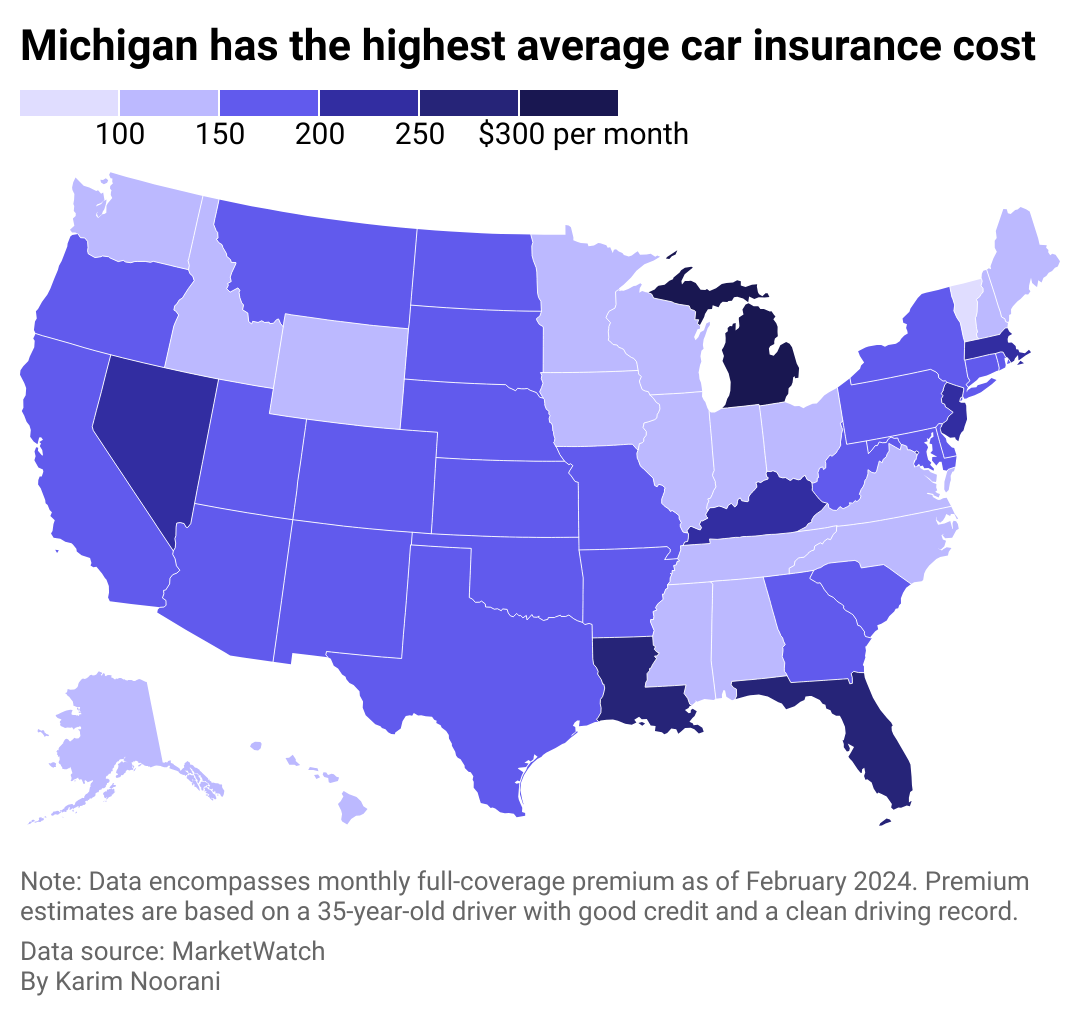
Cheap Insurance
Americans pay $167 per month on average for full-coverage insurance
There are common denominators among the five states where it’s most expensive to have car insurance: Michigan, Florida, Louisiana, Nevada, and Kentucky. Washington D.C. is another pricey locale, ranking #4 overall.
Three of these six are no-fault jurisdictions and require additional coverage beyond coverage to pay for medical costs. Michigan notably calls for $250,000 in personal injury protection (though people with Medicaid and Medicare may qualify for lower limits), $1 million in personal property insurance for damage done by your car in Michigan, and residual bodily injury and property damage liability that starts at $250,000 for a person harmed in an accident.
Other commonalities between these states include high urban population densities. At least 9 in 10 people in Nevada, Florida, and Washington D.C. live in cities and urban areas, which leads to more crashes and thefts and high rates of uninsured drivers and lawsuits. Additionally, Louisiana, Florida, and Kentucky rank #5, #8, and #10, respectively, in motor vehicle crash deaths per 100 million vehicle miles traveled in 2021 based on Department of Transportation data analyzed by the Insurance Institute for Highway Safety.

Canva
#5. Kentucky
– Monthly full-coverage insurance: $210
– Monthly liability insurance: $57

Canva
#4. Nevada
– Monthly full-coverage insurance: $232
– Monthly liability insurance: $107

Canva
#3. Louisiana
– Monthly full-coverage insurance: $253
– Monthly liability insurance: $77

Canva
#2. Florida
– Monthly full-coverage insurance: $270
– Monthly liability insurance: $115

Canva
#1. Michigan
– Monthly full-coverage insurance: $304
– Monthly liability insurance: $113
Story editing by Carren Jao. Copy editing by Paris Close. Photo selection by Lacy Kerrick.
This story originally appeared on Cheap Insurance and was produced and
distributed in partnership with Stacker Studio.
Founded in 2017, Stacker combines data analysis with rich editorial context, drawing on authoritative sources and subject matter experts to drive storytelling.
Featured
-

 Business4 months ago
Business4 months agomesh conference goes deep on AI, with experts focusing in on training, ethics, and risk
-

 Business4 months ago
Business4 months agoSkill-based hiring is the answer to labour shortages, BCG report finds
-

 Events6 months ago
Events6 months agoTop 5 tech and digital transformation events to wrap up 2023
-

 People4 months ago
People4 months agoHow connected technologies trim rework and boost worker safety in hands-on industries
-

 Events3 months ago
Events3 months agoThe Northern Lights Technology & Innovation Forum comes to Calgary next month






